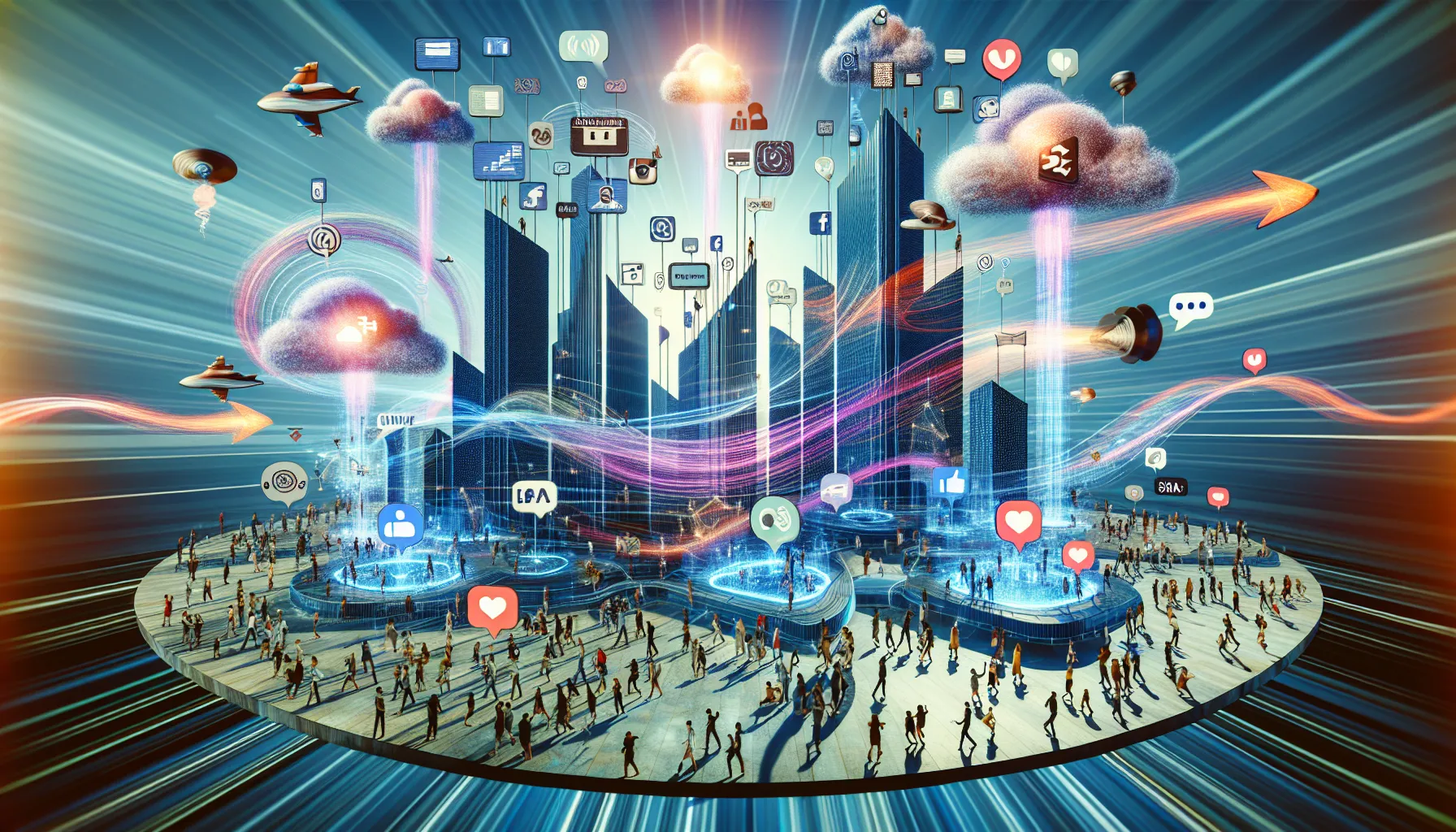As an experienced IELTS instructor, I’m excited to share a comprehensive IELTS Reading practice test focused on the topic “How social media is changing the way consumers interact with brands”. This test will help you prepare for the reading section of the IELTS exam while exploring an important contemporary topic in digital marketing and consumer behavior.
Introduction
The IELTS Reading test consists of three passages of increasing difficulty, followed by a series of questions. Today’s practice test will examine how social media has revolutionized the relationship between consumers and brands. This topic is not only relevant for your IELTS preparation but also provides valuable insights into modern marketing trends and consumer behavior.
IELTS Reading Practice Test
Passage 1 (Easy Text)
The Social Media Revolution in Brand Communication
Social media has fundamentally altered the landscape of consumer-brand interactions. In the past, communication between companies and their customers was largely unidirectional, with brands broadcasting messages through traditional advertising channels. However, the advent of social media platforms has ushered in an era of bidirectional communication, where consumers can directly engage with brands and vice versa.
This shift has empowered consumers in unprecedented ways. They can now voice their opinions, share experiences, and provide feedback in real-time, often to a global audience. Brands, in turn, have had to adapt to this new reality by becoming more responsive and transparent. Many companies now maintain active social media presences, using these platforms not just for marketing, but also for customer service and community building.
The immediacy of social media has also changed consumer expectations. People now expect quick responses to their queries and complaints, often within hours or even minutes. This has led to the rise of social media management teams within companies, dedicated to monitoring and responding to customer interactions across various platforms.
Moreover, social media has become a powerful tool for brand advocacy. Satisfied customers can easily share their positive experiences, effectively becoming brand ambassadors. Conversely, negative experiences can quickly go viral, potentially damaging a brand’s reputation. This double-edged sword has made reputation management on social media a critical aspect of modern brand strategy.
The influencer phenomenon is another significant development in the social media marketing landscape. Influencers, individuals with large social media followings, have become important intermediaries between brands and consumers. Their product recommendations and endorsements can significantly impact consumer behavior, leading many brands to incorporate influencer partnerships into their marketing strategies.
In conclusion, social media has revolutionized the way consumers and brands interact, creating a more dynamic, transparent, and participatory environment. As these platforms continue to evolve, so too will the strategies that brands employ to engage with their audiences in this digital age.
Questions 1-5
Do the following statements agree with the information given in the reading passage?
Write
TRUE if the statement agrees with the information
FALSE if the statement contradicts the information
NOT GIVEN if there is no information on this
- Before social media, communication between brands and consumers was mostly one-way.
- Social media has made it harder for consumers to share their opinions about brands.
- Companies now often have teams dedicated to managing social media interactions.
- All consumer feedback on social media is positive for brands.
- Influencers have become important in connecting brands with consumers.
Questions 6-10
Complete the sentences below.
Choose NO MORE THAN TWO WORDS from the passage for each answer.
- Social media has created an era of __ communication between brands and consumers.
- Consumers now expect __ responses to their queries on social media.
- Satisfied customers sharing positive experiences can become brand __.
- Negative experiences shared on social media can quickly __, potentially harming a brand’s image.
- The __ of social media has changed how quickly consumers expect responses from brands.
Passage 2 (Medium Text)
The Impact of Social Media on Consumer Decision-Making
The proliferation of social media platforms has profoundly altered the consumer decision-making process. Traditional models of consumer behavior have been disrupted by the wealth of information and opinions now available at consumers’ fingertips. This shift has not only changed how consumers research and evaluate products but has also influenced the factors that drive their purchasing decisions.
One of the most significant impacts of social media on consumer decision-making is the increased reliance on peer recommendations. In the past, consumers might have sought advice from friends and family before making a purchase. Now, they have access to reviews and opinions from a global community of users. This electronic word-of-mouth (eWOM) has become a powerful force in shaping consumer perceptions and choices. Studies have shown that consumers trust online reviews almost as much as personal recommendations, making them a critical factor in the decision-making process.
Social media has also accelerated the consumer journey. The traditional linear path from awareness to purchase has been replaced by a more complex, non-linear process. Consumers can now move quickly from discovery to purchase, often within the same platform. For instance, features like Instagram Shopping allow users to see a product in a post and buy it with just a few clicks, compressing the decision-making timeline.
Furthermore, social media has amplified the importance of social proof in consumer decisions. The visibility of others’ choices and experiences on these platforms can significantly influence individual behavior. This phenomenon, known as social validation, can manifest in various ways, from the popularity of a hashtag to the number of likes on a product post. Brands that successfully leverage social proof can create a bandwagon effect, encouraging more consumers to follow suit.
The rise of user-generated content (UGC) on social media has also transformed how consumers evaluate products. Authentic content created by real users, such as unboxing videos or product demonstrations, often carries more weight than polished brand advertisements. This shift has forced brands to adapt their marketing strategies, focusing more on facilitating and showcasing UGC rather than relying solely on traditional advertising methods.
Social media has also introduced new decision-making heuristics for consumers. The abundance of information available can lead to decision fatigue, prompting users to rely on shortcuts or rules of thumb when making choices. For example, the number of followers a brand has or the engagement rate on its posts might be used as quick indicators of quality or popularity.
Lastly, the real-time nature of social media has created a sense of urgency in consumer decision-making. Limited-time offers, flash sales, and live shopping events leverage the fear of missing out (FOMO) to prompt quicker decisions. This urgency, combined with the ease of purchase on many platforms, can lead to more impulsive buying behaviors.
In conclusion, social media has fundamentally reshaped the consumer decision-making landscape. By providing access to vast amounts of information, facilitating peer influence, and creating new shopping paradigms, these platforms have transformed how consumers discover, evaluate, and ultimately choose products and services.
Questions 11-15
Choose the correct letter, A, B, C, or D.
-
According to the passage, which of the following is true about the impact of social media on consumer decision-making?
A) It has made the process simpler and more straightforward.
B) It has increased reliance on traditional advertising.
C) It has made peer recommendations more influential.
D) It has slowed down the consumer journey. -
The term “electronic word-of-mouth” (eWOM) refers to:
A) Email marketing campaigns
B) Online reviews and opinions
C) Voice assistants on smartphones
D) Digital billboards -
How has social media changed the traditional consumer journey?
A) It has made it more linear
B) It has extended the time between awareness and purchase
C) It has made it more complex and non-linear
D) It has eliminated the need for product awareness -
What is “social proof” in the context of social media?
A) A legal document verifying a user’s identity
B) The influence of others’ visible choices on individual behavior
C) A certificate of authenticity for online products
D) The number of followers a user has -
How has user-generated content affected brand marketing strategies?
A) It has made traditional advertising more effective
B) It has reduced the need for any marketing efforts
C) It has forced brands to focus more on facilitating and showcasing UGC
D) It has led to the decline of social media marketing
Questions 16-20
Complete the summary below.
Choose NO MORE THAN TWO WORDS from the passage for each answer.
Social media has significantly impacted consumer decision-making processes. One major change is the increased importance of (16) __, which consumers now trust almost as much as personal recommendations. The traditional (17) __ path from awareness to purchase has been replaced by a more complex process. Social media has also highlighted the role of (18) __ in influencing consumer choices, which can create a bandwagon effect. The rise of (19) __ has forced brands to adapt their marketing strategies. Additionally, the real-time nature of social media has introduced a sense of (20) __ in consumer decision-making, often leading to more impulsive buying behaviors.
Passage 3 (Hard Text)
The Metamorphosis of Brand-Consumer Relationships in the Social Media Era
The advent of social media has catalyzed a paradigm shift in the dynamics between brands and consumers, fundamentally altering the nature of their interactions and relationships. This transformation extends beyond mere changes in communication channels; it represents a profound reconfiguration of power structures, expectations, and engagement modalities in the commercial sphere.
Traditionally, the brand-consumer relationship was characterized by an asymmetrical power dynamic, with brands wielding significant control over information dissemination and narrative construction. The emergence of social media platforms has democratized this relationship, ushering in an era of co-creation and shared brand ownership. Consumers, once passive recipients of brand messaging, have metamorphosed into active participants in brand narratives, wielding unprecedented influence over brand perception and evolution.
This shift has necessitated a recalibration of brand strategies, with a move towards more authentic and transparent communication. The ephemeral nature of social media content, coupled with the speed at which information propagates, has compelled brands to adopt a more agile and responsive approach to engagement. The concept of real-time marketing has gained traction, with brands leveraging current events and cultural moments to create relevant and timely content that resonates with their audience.
Moreover, social media has blurred the lines between personal and commercial spaces, leading to the emergence of what scholars term the “attention economy“. In this new paradigm, consumer attention becomes a scarce and valuable commodity, forcing brands to compete not just with their direct competitors, but with all content creators vying for user engagement. This has led to the adoption of more immersive and interactive marketing strategies, designed to capture and retain consumer attention in an increasingly cluttered digital landscape.
The personalization of brand experiences has reached unprecedented levels, facilitated by the vast amounts of data generated through social media interactions. Algorithmic curation of content has enabled brands to tailor their messaging and offerings to individual preferences and behaviors, creating a more bespoke consumer experience. However, this level of personalization has also raised concerns about privacy and data ethics, prompting ongoing debates about the boundaries of acceptable data use in marketing.
Social media has also catalyzed the rise of brand communities, virtual spaces where consumers coalesce around shared brand affinities. These communities serve multiple functions, acting as forums for product discussion, sources of customer support, and incubators for brand loyalty. The network effects generated by these communities can significantly amplify brand messages and foster a sense of belonging among consumers, but they also pose challenges in terms of community management and brand control.
The disintermediation of traditional marketing channels has led to the emergence of new forms of brand advocacy. Micro-influencers, individuals with smaller but highly engaged followings, have become valuable partners for brands seeking to establish credibility and authenticity within niche markets. This trend reflects a broader shift towards more granular and targeted marketing approaches, enabled by the segmentation capabilities of social media platforms.
Furthermore, social media has accelerated the convergence of commerce and content, giving rise to social commerce as a significant new retail channel. Features such as shoppable posts and in-app purchasing have compressed the consumer journey, enabling impulsive purchasing decisions driven by social proof and peer influence. This integration of social and commercial functions represents a significant evolution in the retail landscape, blending entertainment, social interaction, and commerce in novel ways.
 Social Media Brand Consumer Interaction
Social Media Brand Consumer Interaction
The ephemeral nature of much social media content has also influenced brand-consumer relationships, fostering a culture of constant engagement and FOMO (Fear of Missing Out). Brands must now navigate the tension between creating lasting brand equity and capitalizing on fleeting trends and moments, a balancing act that requires both strategic foresight and tactical agility.
In conclusion, the social media revolution has fundamentally reshaped the terrain of brand-consumer relationships, ushering in an era of greater reciprocity, transparency, and co-creation. As these platforms continue to evolve, so too will the strategies and paradigms governing brand-consumer interactions, necessitating ongoing adaptation and innovation from marketers and brand strategists alike.
Questions 21-26
Choose the correct letter, A, B, C, or D.
-
According to the passage, how has social media changed the power dynamic between brands and consumers?
A) It has given brands more control over information
B) It has created a more balanced relationship
C) It has made consumers completely dominant
D) It has not affected the power dynamic -
What does the term “attention economy” refer to in the context of social media marketing?
A) The monetary value of advertising on social media
B) The competition for consumer attention as a valuable resource
C) The economy of scale in social media advertising
D) The attention span of social media users -
How has personalization in brand experiences changed due to social media?
A) It has become less important
B) It has reached unprecedented levels
C) It has remained the same as before
D) It has been completely eliminated -
What role do brand communities play in social media marketing?
A) They only serve as customer support forums
B) They have no significant impact on brand loyalty
C) They act as multifunctional spaces for brand engagement
D) They are used exclusively for product sales -
How has social media affected the consumer journey in retail?
A) It has made the journey longer and more complex
B) It has not had any significant impact
C) It has compressed the journey, enabling quicker purchases
D) It has eliminated the need for physical retail stores -
What challenge does the ephemeral nature of social media content present to brands?
A) It makes creating content unnecessary
B) It requires balancing lasting brand equity with capitalizing on trends
C) It eliminates the need for long-term brand strategies
D) It has no effect on brand marketing strategies
Questions 27-30
Complete the sentences below.
Choose NO MORE THAN TWO WORDS from the passage for each answer.
-
The emergence of social media has led to an era of __ and shared brand ownership between brands and consumers.
-
Brands are now adopting more __ marketing strategies to capture consumer attention in a cluttered digital landscape.
-
The rise of __ has created new forms of brand advocacy, particularly in niche markets.
-
Social media has accelerated the __ of commerce and content, giving rise to social commerce as a new retail channel.
Answer Key
Passage 1
- TRUE
- FALSE
- TRUE
- NOT GIVEN
- TRUE
- bidirectional
- quick
- ambassadors
- go viral
- immediacy
Passage 2
- C
- B
- C
- B
- C
- peer recommendations
- linear
- social proof
- user-generated content
- urgency
Passage 3
- B
- B
- B
- C
- C
- B
- co-creation
- immersive
- micro-influencers
- convergence
This IELTS Reading practice test explores the multifaceted impact of social media on consumer-brand interactions. From changing communication dynamics to reshaping decision-making processes and transforming marketing strategies, social media has revolutionized the way businesses and consumers engage with each other. By practicing with this test, you’ll not only improve your IELTS Reading skills but also gain valuable insights into contemporary digital marketing trends.
Remember to time yourself and practice under exam conditions to maximize the benefits of this exercise. Good luck with your IELTS preparation!
For more IELTS practice and tips, check out our other resources:


